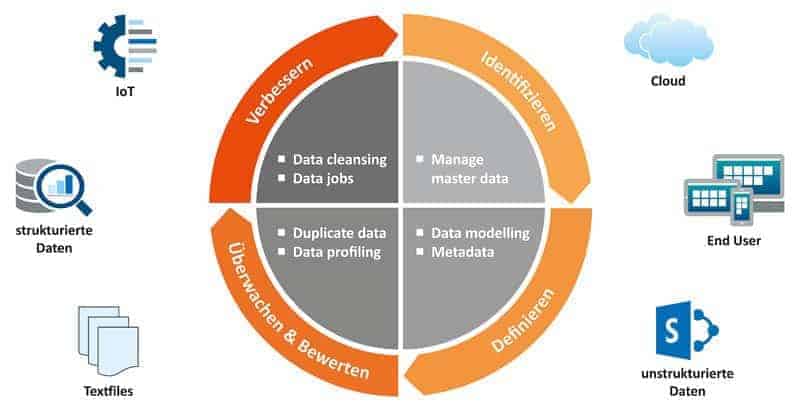The S/4 world from four perspectives


Alegri accompanies its customers holistically on their way into the S/4 Hana world, neutrally and independently. This is exemplified from four perspectives.
1. use S/4 Hana functionality without switching!
A switch to S/4 Hana is often costly and not feasible in the short term. However, the significantly improved functionality of S/4 Hana can bring great benefits. Alegri has developed a methodology to square the circle: new functionality and a low burden on the customer's often thin staffing levels, so that the ROI is realized in the short term.
One component of this methodology is the use of S/4 Hana functionality as a booster for the existing ECC 6.0 environment. This allows the enhanced functionality of S/4 Hana to be used for selected value-adding processes in the short term, but the existing business processes in the core system remain unchanged.
Using procurement as an example, this means that there are procurement functionalities in every production system (one or more ERP, SRM and APO systems, decentralized 3rd party solutions). These can be optimized by synchronizing the necessary data to a central system on S/4 Hana. There are many reasons for this, e.g. procurement for cost centers:
- Possibility to support the release processes with modern interfaces, e.g. with standard Fiori apps for releases
- Central shopping cards for office and IT materials, e.g. PCs, monitors, printers, toners, licenses
- Fast supply of the departments with low handling costs
- Few, but intensive and cost-optimized supplier relationships
- Possibility to have warehouses managed by suppliers
- in procurement of raw materials and components: Lower inventory risk with faster availability of components
- Purchasing optimized for batch size and thus cost advantages
- Inventory overview and thus shortened delivery times
- Significantly lower handling costs in purchasing
- Use of SCM functionalities (formerly APO) to optimize processes across plants
Alegri Procurement Booster Methodology:
To take advantage of these improved functionalities in the short term, Alegri sets up an S/4 Hana system and connects it to the existing ECC systems. This enables customers to enter the new S/4 Hana world with minimal risk.
At the same time, synergy effects are exploited and the transition to the S/4 Hana environment is completed step by step. The bidirectional connection of the new S/4 Hana system enables the seamless continued use of existing ECC systems.
Cloud scenarios for the S/4 Hana systems are possible, since the systems do not necessarily have to be operated in the company's own data center (as well as a rental model for the licenses, if necessary). This means that new S/4 Hana functionalities can be tested at low risk and without extensive investment, and optimal operation can be realized 7/24 for global processes at optimal cost.
The Alegri Procurement Booster methodology offers the opportunity to introduce SAP procurement functionality from S/4 Hana in steps that are compatible with customers and projects.
2. goldmine data! EIM/Data Services Exchange
Data exchange and information management are now among the most important disciplines in enterprise IT. Business units want agility and flexibility in the use of IT systems for themselves and their customers.
Efficient business processes require centralized and high-quality data; data management must not become a "show stopper". Companies must therefore establish efficient data "handling".
Practice shows that many questions about company data can often only be answered incompletely, e.g.:
- What data is available in the company?
- Who is responsible for the data?
- What is the quality of the data?
- Where is the data used, what media breaks are there?
- What data has value for the company?
- Which data causes unnecessary costs?
Today, information governance is more than ever a strategic task. Companies operate in a complex, technical environment. Information is becoming increasingly valuable and business-critical - must be managed professionally. This concerns data efficiency/integration (data architecture and clear responsibility), quality (specifications and processes) and also the management of the information lifecycle (specifications and processes).
It is advisable to seek professional support for a primary setup. A first step is often to establish responsibility for information management. In many companies, it has been recognized that data management is a "full-time job" and the role of Chief Data Officer is created for this purpose.
The CDO drives the digital transformation in the company, in which processes and roles for managing data and information are established. A clear understanding of the data architecture in the company is ensured and the company-wide enforcement of the defined and agreed information governance is ensured.
3. the (r)evolution of the SAP world
With new products in PaaS, SaaS and IaaS, SAP is positioning itself much more diversely than before. The client-server principle, in which all data and processes are provided together in as few central systems as possible, is being greatly expanded for the digital transformation.
The aim is to decentralize processes around a centralization of data ("single source of truth"). Business-critical and relevant data remains in the "digital core", the S/4 Hana system.
The majority of operational processes are shifting more to web-based applications from on-premise sources and XaaS clouds. In addition, there are new data and processes from the digital transformation that need to be integrated into existing and future data and process structures.
IoT data from a wide variety of sources must be transferred quickly, in a structured manner, and with high quality as valuable information into the company's own infrastructure and system landscape.
PaaS with SAP CP and Leonardo, the SAP platform for digital innovation, is exciting for IT architects. Many opportunities lie dormant in the variety of services offered here. Combining these services with customer-specific services and USPs and optimizing them to enhance performance is the art - e.g., in Industry 4.0, agriculture, or sports.
However, thinking further, the next challenge with the centralized approach arises in data management. The more dynamic data streams have to be taken into account in the processes, the faster the volume of data grows.
The limit of the amount of data that can be managed efficiently and economically is reached at some point, even with SAP Hana. Here, you have to take a close look at the data. Which data is useful and important in the core system?
Edge computing is the keyword here for upstream processing and filtering of data streams and initial quality assessment. Only what corresponds to well-defined KPIs is passed on for further processing.
This relieves the burden on core systems, infrastructure, administration, can improve security and governance, and accelerates the evaluation of valuable data. The challenge with edge computing lies in defining the KPIs for data quality decisions and the lifecycle management of the edge component.
The change to this (r)evolutionary IT landscape requires vision, experience and long-term master planning! The initial hype is already over, now consistent planning and implementation must take place.
Important activities in information management
- Identify
- Determine data origin
- Cause and source of insufficient data
- Define
- Application of information governance
- Business Glossary
- Monitor/evaluate
- Data Quality Scorecards
- Valuation for transparency
- Improve
- Rules for data cleansing
- Establish workflows
[/av_promobox]
4. cost reduction through benchmark
The IT innovations at the DSAG Annual Congress promise greatly improved functionalities. But these come at a price and the IT budget is often limited. It is therefore important to actively optimize the cost side, e.g.: by converting operating costs into free IT budget for innovations, a fair price for IT outsourcing providers, especially in the case of contract extensions or new tenders, and by defending the IT budget in the case of across-the-board cost cuts.
The comparison with the market to identify savings potentials, the so-called benchmarking, is a proven, successful approach.The Alegri SAP operating cost benchmark differs in breadth and depth from conventional benchmarks on the market: This is based on the knowledge from over 4500 optimizations performed.
The SAP systems are analyzed in detail (> 1000 measurement points) taking into account usage, complexity, quality and performance of the SAP landscape. This means that a global SAP ERP system with all modules in use is also only compared with similar SAP ERP systems. The benchmark is therefore fair and robust.
Costs are recorded in a proven model that adapts to the company's organizational structure. Conversely, if predetermined Excel tables were filled, the input data would often be incorrectly categorized.
In addition to the technical facts, it is important to consider the general conditions. A global company has different economies of scale than a medium-sized company, an outsourcing contract with a long term has different conditions than a three-year contract, a bank has increased security requirements, and so on.
The results are detailed by SAP area (application support, SAP Basis, hosting, licenses, user administration, etc.) so that cost drivers can be precisely identified and addressed. The focus is on optimization.
Thanks to the precise measurement of SAP systems, the large comparison base and the experienced consultants, the Alegri SAP operating cost benchmark has become established and recognized. It has been possible to reduce operating costs by an average of over 20 percent for each customer over the past few years while maintaining the same level of performance.







